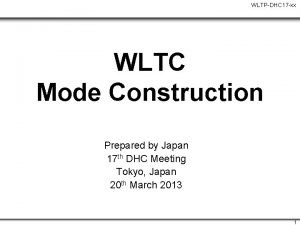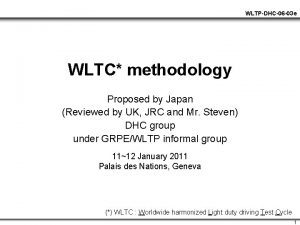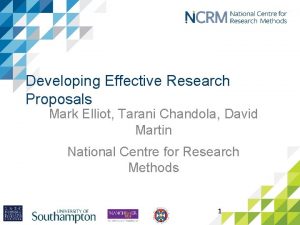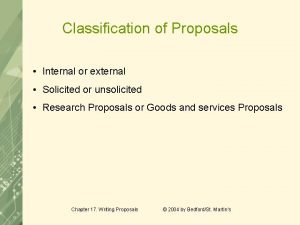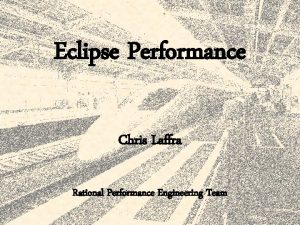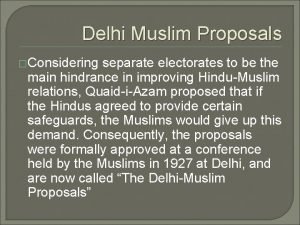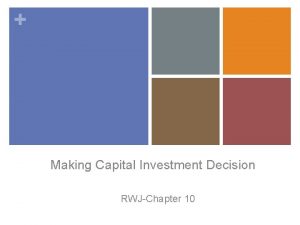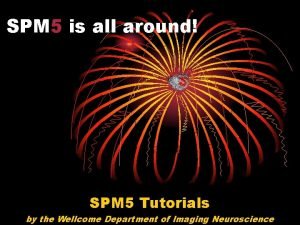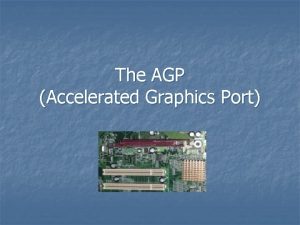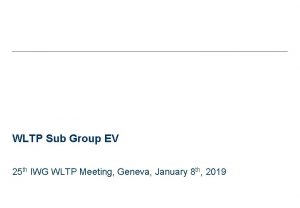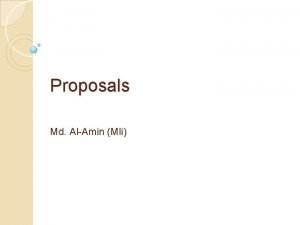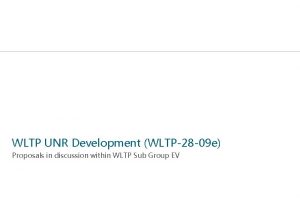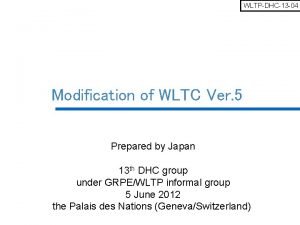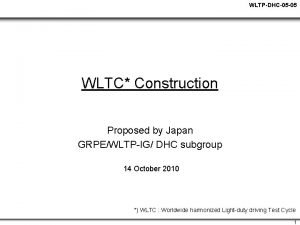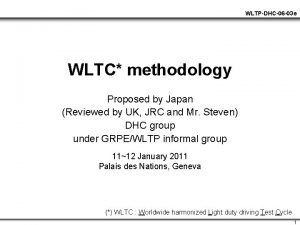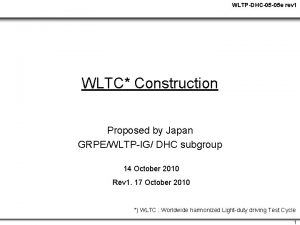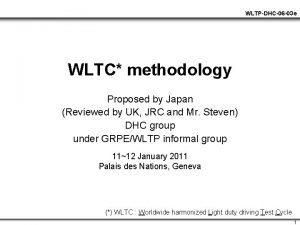WLTP Proposals of WLTC versions for low powered



















![Proposal for vehicle classes Ø Class 3: pmr >= [35] k. W/t, § v_max Proposal for vehicle classes Ø Class 3: pmr >= [35] k. W/t, § v_max](https://slidetodoc.com/presentation_image/c9b856ef34da0bff14359ec798e37e8f/image-20.jpg)
- Slides: 20

WLTP Proposals of WLTC versions for low powered vehicles Heinz Steven 09. 03. 2012 1

Content • Structure of the additional in-use data from India and Overview of the whole Indian in-use data, • Analysis of positive acceleration percentiles, Ø Per vehicle, Ø Per region, • Analysis of relative positive accelerations, • Proposal for vehicle classes, • Summary and conclusions 2

Vehicle classification • Based on the analysis results of the acceleration performance of the vehicles in the WLTP in-use database (see WLTP-DHC-TC 06032012 -02_Analyses_related_to_low_powered_vehicles. pptx) the following draft vehicle classification was used for the cycle development: Ø Class 1: pmr < 21 k. W/t, Ø Class 2: 21 k. W/t <= pmr < 35 k. W/t, Ø Class 3: pmr >= 35 k. W/t. • The 6 vehicles in class 1 are all from India, the 5 vehicles in class 2 are from India (3), Japan (1) and Europe (1). • The in-use database for class 1 vehicles contains short trips from the low and the medium speed part, the in-use database for class 2 vehicles contains ST from low, medium and high speed parts. 3

Development approach • The cycle for class 3 vehicles is WLTC version 4 as used for validation 1 b consisting of the 4 speed parts low, medium, high and extra high. • The following approach was used for the development of complementary cycles for class 1 and 2 vehicles: Ø According to the in-use databases the extra high speed part was skipped for class 2 vehicles and the extra high speed part as well as the high speed part were skipped for class 1 vehicles. Ø The structure of the cycle parts in terms of cycle duration, idle time percentages and number and duration of short trips were taken over from WLTC version 4. Ø The vehicle speed - acceleration distributions for class 1, class 2 and class 3 were calculated from the corresponding parts of the WLTP database. 4

Development approach Ø This calculation was performed with equal weightings for the individual vehicles within the 3 classes. Ø The class 3 distributions were used for a comparison with the WWW database distributions. Ø The short trips for the class 1 and class 2 cycles were then chosen from the database on the basis of a least square analysis. In this analysis only positive accelerations were taken into account. Ø Further modifications on the candidate short trips were necessary in order to bring the distributions closer to the database distributions and in order to make sure that the acceleration values would be within the limits defined by the speed dependent acceleration distributions (<= a_95). Ø But it must be pointed out, that no smoothing of microtransients was applied so far. 5

Results • The following conclusions could be drawn from initial analysis results related to low powered vehicles: Ø It must clearly be stated that a separate cycle version for the low speed part is required for vehicles with power to mass ratios (pmr) below 20 k. W/t. Since this separate version cannot be derived from the existing WLTC because only 2 vehicles belong to this class, more in-use data was required for the development. Ø It could well be that vehicles with pmr below 30/35 k. W/t would also need cycle versions with reduced accelerations for the low and medium speed parts but since there was only 1 vehicle in this pmr class no general conclusions could be drawn without additional inuse data. • In the meantime India delivered additional in-use data for 9 vehicles with pmr between 9. 1 and 29. 1 k. W/t. 6

Class 1, low speed part Figure 1 7

Class 1, medium speed part Figure 2 8

Class 2, low speed part Figure 3 9

Class 2, medium speed part Figure 4 10

Class 2, high speed part Figure 5 11

Comparison of distributions with DB • The mentioned modifications were made in order to get a better fit with the database distributions. • The following figures show the corresponding comparisons. • The fit is generally equally good as for the WLTC version 4 and the WWW database distributions. • The latter are in good accordance with the class 3 distributions, at least for the low and medium speed parts. 12

Vehicle speeds, low speed part Figure 6 13

Accelerations, low speed part Figure 7 14

Vehicle speeds, medium speed part Figure 8 15

Accelerations, medium speed part Figure 9 16

Vehicle speeds, high speed part Figure 10 17

Accelerations, high speed part Figure 11 18

Proposal for vehicle classes • Based on the analysis results the following amended draft vehicle classification is proposed (square brackets means to be discussed and decided): Ø Class 1: pmr < [21] k. W/t, ü v_max < [70] km/h, low speed part with highly reduced accelerations, ü v_max >= [70] km/h, low and medium speed parts with highly reduced accelerations. Ø Class 2: [21] k. W/t <= pmr < [35] k. W/t, ü v_max < [90] km/h, low and medium speed parts with reduced accelerations, ü v_max >= [90] km/h, low, medium and high speed parts with reduced accelerations. 19
![Proposal for vehicle classes Ø Class 3 pmr 35 k Wt vmax Proposal for vehicle classes Ø Class 3: pmr >= [35] k. W/t, § v_max](https://slidetodoc.com/presentation_image/c9b856ef34da0bff14359ec798e37e8f/image-20.jpg)
Proposal for vehicle classes Ø Class 3: pmr >= [35] k. W/t, § v_max < [135] km/h, low, medium and high speed parts only, § v_max >= [135] km/h, all parts • This proposal is intended as starting point for the discussion and needs to be further evaluated. 20
 Wltc mode
Wltc mode Wltc japan
Wltc japan Artificial intelligence thesis proposals
Artificial intelligence thesis proposals Developing effective research proposals
Developing effective research proposals Completing reports and proposals
Completing reports and proposals Why use headings for an external solicited proposal?
Why use headings for an external solicited proposal? Eclipse computing proposals slow
Eclipse computing proposals slow Writing and completing reports and proposals
Writing and completing reports and proposals Nature and use of fire insurance
Nature and use of fire insurance Delhi muslim proposals
Delhi muslim proposals Business proposal chapter 10
Business proposal chapter 10 Capital investment decision
Capital investment decision Writing thesis and dissertation proposals
Writing thesis and dissertation proposals High precision vs high accuracy
High precision vs high accuracy Sociability continuum
Sociability continuum Low voltage = low hazard
Low voltage = low hazard Middle = low + (high - low) / 2
Middle = low + (high - low) / 2 Snow white and the seven dwarfs gender roles
Snow white and the seven dwarfs gender roles Spm 5
Spm 5 Agp accelerated graphics port
Agp accelerated graphics port Sic instruction format
Sic instruction format
